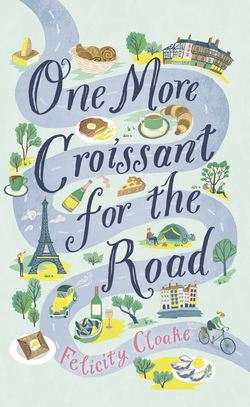Читать книгу One More Croissant for the Road - Felicity Cloake - Страница 24
A Platter of Oysters
ОглавлениеOysters need little introduction, save to say that Brittany produces some exceptionally fine examples, which are best – as with all oysters in my opinion – served naked or perhaps with the merest dribble of shallot vinaigrette, preferably within sight of the salty waters from whence they came.
The next morning brings two excitements. Firstly, it’s Matt’s last day, a terrifying fact that I’m trying to avoid staring full in the face, and secondly, this comes just as he’s proved himself indispensable with the information that there’s a drive-through boulangerie round the corner. A DRIVE-THROUGH boulangerie. I literally could not be more thrilled if he’d added they were giving out free croissants.
The reality is even more perfect than I’d imagined: as a former petrol station repurposed to dispense human fuel, it even looks the part. Obviously I make Matt hang back to take a photo as I pedal up to the window. The girl serving seems amused to see me pop up in front of her: ‘No, we don’t get very many bikes!’ she says cheerfully, handing over the goods for me to clutch awkwardly in one hand while steering with the other. Matt and I reconvene on the forecourt as a huge dog in the car behind actually attempts to climb over its owner and through the hatch: my croissant is a bit burnt, but I have absolutely no regrets – 10/10 for both novelty and practicality (and 7/10 for the actual goods).
That said, Matt’s imminent departure seems a fair excuse for a second crack at a final breakfast, especially when we pass a boulangerie whose window proudly displays golden laurels for baking the second-best baguette tradition (see here, Pause-Café – French Bread: A Bluffer’s Guide) in all of Brittany. Their croissant isn’t bad either (7.5, well flavoured, let down by a slight sponginess in the middle), but it’s overshadowed by my impulse purchase: a golden kouign-amann apiece, sporting a jaunty Breton flag, which I immediately stick on my handlebars.
If I think too hard about the 30-odd years of my life spent in ignorance of these unassuming-looking pastries, I start to feel a bit sad; like a sweeter, crunchier version of the best croissant you’ve ever eaten, soaked in buttery syrup and baked until crisp, they’re incredibly rich and stupidly delicious, and I can’t in all conscience let Matt leave Brittany without trying one. Even I struggle after two croissants, however, and the second half of the little cake ends up in the bag on my handlebars for later – something that will happen so often in the weeks to come I’m surprised I don’t have a fully-formed bread-and-butter pudding in there by the time I get to Paris.
On the way out of Dol, wobbling through pretty but uncomfortably cobbled streets, we pass a huge cathedral with a tower that looks like it’s been abruptly snapped off. Actually, as I discover from the information boards with which Dol is well furnished, it was never finished, due to ‘insufficient funds’ (or the devil throwing an enormous menhir in the works, depending on whose version you believe). The unexpected grandeur of the church is explained by the fact that, until drainage work took place in the 11th century, the sea reached as far as Dol-de-Bretagne, making this morning’s route a ghostly seabed.
Having undergone serious adjustment at the hands of the hostel receptionist, who refuses to check us out until he’s politely pooh-poohed my plans, this meanders towards the modern coast by way of Mont Dol, which, at 65 metres tall, counts as a significant peak in this part of the world. Indeed, once upon a time it was an island, just like Mont-Saint-Michel. Apparently, St Michael, patron saint of France as well as sensible knitwear, fought a duel with Satan at the top, but Matt doesn’t show much enthusiasm for climbing it to see the ‘certain curious marks’ the battle left in the rock, so we leave it be and head for the sea instead.
The D155 is one of those glorious roads that spools out in front of your wheel, allowing you to see exactly where you’re heading for miles before you get there, lined on one side with squat granite houses staring out across the marshes and clusters of corrugated sheds advertising ‘creuses de Cancale: vente au detail’ (creuses, or hollow oysters, being the French name for what we call rock oysters).
The air is heavy with the iodine reek of shellfish, whetting my appetite for what I hope lies ahead of us in Cancale, known across France as the oyster capital of Brittany – though first we have to contend with one of Google Maps’ helpful cycle routes, which takes us up a road at first stony, and then muddy, and finally all but impassable on a delicate beast like Eddy, whose mudguards quickly fill up with the stuff. Eventually I have to get off and push before I’m thrown off like a questing knight who has finally pushed his patient steed too far.
Though I haven’t got round to mentioning it to Matt, I’ve plotted a course that just happens to pass right by La Ferme Marine de Cancale, which, its website promises, offers ‘a fantastic one-hour-and-a-half tour!’ Fortunately, it’s well signposted from the road, allowing me to discover it with delighted surprise, a surprise that becomes all too real when I learn that it’s closed, so instead of prying into ‘the secrets of the oysters’, we pedal on to the town of Cancale proper, and the not-so-secret oyster market at the end of the harbour (‘#1 of 11 things to do in Cancale!’). The wide road along the bay is fringed with seafood restaurants gearing up for the Tuesday lunchtime trickle, culminating in the market, a clutch of striped tents above the concrete slipway, facing inwards against the wind.
